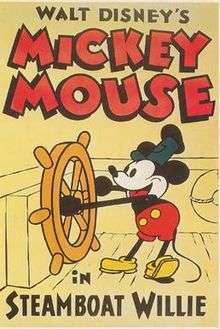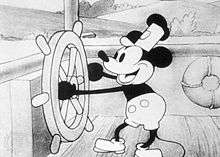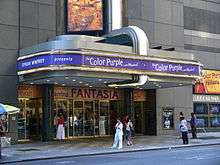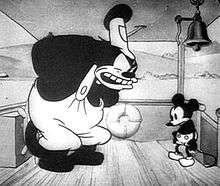Steamboat Willie
| Steamboat Willie | |
|---|---|
| Mickey Mouse series | |
 50th anniversary poster, 1978[1] | |
| Directed by |
Walt Disney Ub Iwerks |
| Produced by |
Roy O. Disney Walt Disney |
| Story by |
Walt Disney Ub Iwerks |
| Voices by | Walt Disney |
| Music by |
Wilfred Jackson Bert Lewis |
| Animation by |
Les Clark (inbetweener) Ub Iwerks Wilfred Jackson |
| Studio | Walt Disney Studios |
| Distributed by |
Celebrity Productions Cinephone(Recorded) |
| Release date(s) |
(USA) |
| Color process | Black and white |
| Running time | 7 min. 42 sec. |
| Country | United States |
| Preceded by | First release |
| Followed by | The Gallopin' Gaucho |
Steamboat Willie is a 1928 American animated short film directed by Walt Disney and Ub Iwerks. It was produced in black-and-white by Walt Disney Studios and was released by Celebrity Productions. The cartoon is considered the debut of Mickey Mouse[2] and his girlfriend Minnie, although both the characters appeared several months earlier in a test screening of Plane Crazy. Steamboat Willie was the third of Mickey's films to be produced, but was the first to be distributed because Walt Disney, having seen The Jazz Singer, had committed himself to producing the first fully synchronized sound cartoon.[3]
Steamboat Willie is especially notable for being the first Disney cartoon with synchronized sound, including character sounds and a musical score. Disney understood from early on that synchronized sound was the future of film. It was the first cartoon to feature a fully post-produced soundtrack which distinguished it from earlier sound cartoons such as Inkwell Studios' Song Car-Tunes (1924–1927) and Van Beuren Studios' Dinner Time (1928). Steamboat Willie became the most popular cartoon of its day.[4]
Music for Steamboat Willie was arranged by Wilfred Jackson and Bert Lewis, and included the songs "Steamboat Bill", a composition popularized by baritone Arthur Collins during the 1910s, and "Turkey in the Straw" , a composition popularized within minstrelsy during the 19th century. The title of the film is a parody of the Buster Keaton film Steamboat Bill Jr. (1928),[5] itself a reference to the song by Collins. Walt Disney performed all of the voices in the film, although there is little intelligible dialogue.[6]
While the film has received some criticism, it has also received wide critical acclaim, not only for introducing one of the world's most popular cartoon characters, but for its technical innovation. In 1994 members of the animation field voted Steamboat Willie 13th in the book The 50 Greatest Cartoons, which listed the greatest cartoons of all time. In 1998 the film was selected for preservation in the United States' National Film Registry for being deemed "culturally, historically, or aesthetically significant."[3]
Synopsis

Mickey Mouse pilots a river steamboat, suggesting that he himself is the captain. He cheerfully whistles "Steamboat Bill" and sounds the boat's three whistles. Soon the real captain, Pete, appears and orders Mickey off the bridge. Mickey blows a raspberry at Pete, and then Pete attempts to kick him but Mickey rushes away in time and Pete kicks himself in the rear accidentally. Mickey rushes down the stairs, slips on a bar of soap on the boat's deck and lands in a bucket of water. A parrot laughs at him, and Mickey throws the bucket at it.
Pete, who has been watching the whole thing, pilots the steamboat himself. He bites off some chewing tobacco and spits into the wind. The spit flies backward and rings the boat's bell. Amused by this Pete spits again, but it hits himself in the face, making him fuss.
The steamboat makes a stop at "Podunk Landing" to pick up a cargo of various livestock. Just as they set off again, Minnie appears, running to catch the boat before it leaves. Mickey does not see her in time, but she runs after the boat along the shore and Mickey takes her on board by hooking the cargo crane to her underwear.
Landing on deck, Minnie accidentally drops a guitar and some sheet music for the song "Turkey in the Straw" which are eaten by a goat. The two mice use the goat's body as a phonograph which they play by turning its tail like a crank. Mickey uses various objects on the boat as percussion accompaniment and "plays" the animals like musical instruments. This ends with them using a Clarabelle Cow's teeth to play the song as a xylophone.[7][8][9]
Finally Captain Pete is unamused and puts Mickey to work peeling potatoes. In the potato bin, another parrot appears in the port hole and laughs at him again. The mouse throws a peeled potato at him, knocking him into the river below. The film ends with Mickey laughing.
Background
According to Roy O. Disney, Walt Disney was inspired to create a sound cartoon after watching The Jazz Singer (1927).[3] Disney had intended for Mickey Mouse to be the new star character to replace Oswald the Lucky Rabbit after he lost the rights to the character to Charles Mintz. However, the first two Mickey Mouse films produced, silent versions of Plane Crazy and The Gallopin' Gaucho, had failed to impress audiences and gain a distributor. Disney believed that adding sound to a cartoon would greatly increase its appeal.
Steamboat Willie was not the first cartoon with synchronized sound. Starting in May 1924 and continuing through September 1926, Dave and Max Fleischer's Inkwell Studios produced 19 sound cartoons, part of the Song Car-Tunes series, using the Phonofilm sound-on-film process. However, the Song Car-Tunes failed to keep the sound fully synchronized, while Steamboat Willie was produced using a click track to keep his musicians on the beat.[10] As little as one month before Steamboat Willie was released, Paul Terry released Dinner Time which also used a soundtrack, but Dinner Time was not a financial success.
In June 1927, producer Pat Powers made an unsuccessful takeover bid for Lee DeForest's Phonofilm Corporation. In the aftermath, Powers hired a former DeForest technician, William Garrity, to produce a cloned version of the Phonofilm system, which Powers dubbed "Powers Cinephone". By then, DeForest was in too weak a financial position to mount a legal challenge against Powers for patent infringement. Powers convinced Disney to use Cinephone for Steamboat Willie; their business relationship lasted until 1930, when Powers and Disney had a falling-out over money and Powers hired away Disney's lead animator, Ub Iwerks.
Production
The production of Steamboat Willie took place between July and September 1928 with an estimated budget of $4,986.[3] There was initially some doubt among the animators that a sound cartoon would appear believable enough, so before a soundtrack was produced, Disney arranged for a screening of the film to a test audience with live sound to accompany it.[11] This screening took place on July 29 with Steamboat Willie only partly finished. The audience sat in a room adjoining Walt's office. Roy placed the movie projector outdoors and the film was projected through a window so that the sound of the projector would not interfere with the live sound. Ub Iwerks set up a bedsheet behind the movie screen behind which he placed a microphone connected to speakers where the audience would sit. The live sound was produced from behind the bedsheet. Wilfred Jackson played the music on a mouth organ, Ub Iwerks banged on pots and pans for the percussion segment, and Johnny Cannon provided sound effects with various devices, including slide whistles and spittoons for bells. Walt himself provided what little dialogue there was to the film, mostly grunts, laughs, and squawks. After several practices, they were ready for the audience, which consisted of Disney employees and their wives.
The response of the audience was extremely positive, and it gave Walt the confidence to move forward and complete the film. He said later in recalling this first viewing, "The effect on our little audience was nothing less than electric. They responded almost instinctively to this union of sound and motion. I thought they were kidding me. So they put me in the audience and ran the action again. It was terrible, but it was wonderful! And it was something new!" Iwerks said, "I've never been so thrilled in my life. Nothing since has ever equaled it."[12]
Walt traveled to New York City to hire a company to produce the sound system. He eventually settled on Pat Powers's Cinephone system, created by Powers using an updated version of Lee De Forest's Phonofilm system without giving De Forest any credit, a decision he would later regret.
The music in the final soundtrack was performed by the Green Brothers Novelty Band and was conducted by Carl Edouarde. The brothers Joe and Lew Green from the band also assisted in timing the music to the film. The first attempt to synchronize the recording with the film, done on September 15, 1928, was a disaster.[13] Disney had to sell his Moon roadster in order to finance a second recording. This was a success with the addition of a filmed bouncing ball to keep the tempo.[14]
Release and reception

Steamboat Willie premiered at Universal's Colony Theater in New York City on November 18, 1928.[15] The film was distributed by Celebrity Productions and its initial run lasted two weeks. Disney was paid $500 a week which was considered a large amount at the time.[14] It played ahead of the independent feature film Gang War. Steamboat Willie was an immediate hit while Gang War is all but forgotten today.[4]
The success of Steamboat Willie not only led to international fame for Walt Disney, but for Mickey as well. On November 21, Variety magazine published a review which read in part "Not the first animated cartoon to be synchronized with sound effects, but the first to attract favorable attention. [Steamboat Willie] represents a high order of cartoon ingenuity, cleverly combined with sound effects. The union brought laughs galore. Giggles came so fast at the Colony [Theater] they were stumbling over each other."
The response led to the two previous Mickey films being reproduced as sound cartoons and given wide theatrical releases.
Copyright status

The film has been the center of a variety of controversies regarding copyright. The copyright of the film has been extended by an act of the United States Congress. However, recent evidence suggests that the film may be in the public domain owing to technicalities related to the original copyright notice.
The film has been the center of some attention regarding the 1998 Copyright Term Extension Act passed in the United States. Steamboat Willie has been close to entering the public domain in the U.S. several times. Each time, copyright protection has been extended. It could have entered public domain in four different years: first in 1956, renewed to 1984, then to 2003 by the Copyright Act of 1976, and finally to the current public domain date of 2023 by the Copyright Term Extension Act (also known pejoratively as the "Mickey Mouse Protection Act")[16] of 1998. The U.S. copyright on Steamboat Willie will be in effect through 2023 unless there is another extension of the law.
It has been claimed[17] that these extensions were a response by Congress to extensive lobbying by The Walt Disney Company.
In the 1990s, former Disney researcher Gregory S. Brown determined that the film was likely in U.S. public domain already due to errors in the original copyright formulation.[18] In particular, the original film's copyright notice had two additional names between Disney and the copyright statement. Thus, under the rules of the Copyright Act of 1909, all copyright claims would be null.[18] Arizona State University professor Dennis Karjala suggested that one of his law school students look into Brown's claim as a class project. Lauren Vanpelt took up the challenge and produced a paper agreeing with Brown's claim. She posted her project on the Internet in 1999.[19] Disney later threatened to sue a Georgetown University law student who wrote a paper confirming Brown's claims,[20] alleging that publishing the paper could be slander of title.[21]
In other media
Steamboat Willie themed levels are featured in the video games Mickey Mania (1994), Kingdom Hearts II (2005), and Epic Mickey (2010). Furthermore, in Epic Mickey 2: The Power of Two (2012), a "Steamboat Willie" outfit can be obtained for Mickey.
The fourth season episode of The Simpsons, "Itchy & Scratchy: The Movie" features a short but nearly frame-for-frame parody of the opening scene of Steamboat Willie.
In the 1998 film Saving Private Ryan, set in 1944, a German POW tries to win the sympathy of his American captors by mentioning Steamboat Willie, even mimicking the sound of the boat whistle from the film. The unnamed character appears in the credits as "Steamboat Willie".
In the 2000 Mickey Mouse cartoon April Fools' Day, Mickey and Mortimer get sent to the President's office to claim a million dollars. But Mortimer pretends to be Mickey and he is shown acting in Steamboat Willie.
In the Goofy cartoon How to Be a Waiter (1999), Goofy is shown an example of a movie, and Steamboat Willie is shown. But in that short, Willie is a shortened version titled Steamboat Goofy.
The opening scene was parodied towards the end of Aladdin and the King of Thieves. Genie, having been swallowed by the giant turtle which carried the Vanishing Isle upon its back, came back out of the turtle's mouth in the steamboat from this film and was even in Mickey's form, whistling Turkey in the Straw.
In a 2008 movie of the TV series Futurama called The Beast with a Billion Backs the opening is a parody of Steamboat Willie.
The beginning of series 2 of the TV series Alexei Sayle's Stuff (1989) shows a black and white animation entitled Steamboat Fatty, a parody of Steamboat Willie.
In the Pokémon: Diamond and Pearl anime, one of the episodes "Steamboat Willies!", is a play on the title.
Since the release of Meet the Robinsons (2007), the scene of Mickey at the wheel of the steamboat whistling "Steamboat Bill" has been used for Walt Disney Animation Studios' production logo. A modification was used for Tangled (2010) to mark that film as the 50th in their Classics line, the text saying "Walt Disney Animation Studios: 50th Animated Motion Picture" with the Mickey scene in the "0". An 8-bit version of the logo was used for Wreck-It Ralph (2012), and in Frozen (2013), Mickey's whistling was muted to allow the film's opening song, "Vuelie", to play out over the logo, breaking tradition Disney Logo.
This cartoon was featured in Disney's Magical Mirror Starring Mickey Mouse.
The Australian Perth Mint releases a 1 kg Gold coin in honour of Steamboat Willie. The AU$5000 coin can sell for AU$69,700 as an official Disney licensed product.[22]
The upcoming second season of Transformers: Robots in Disguise, this episode would be the two part episode "Steamboat Willows".
Honors
Steamboat Willie was inducted to the National Film Registry in 1998.
Release history
- 1928 July – First test screening
- 1928 November – Original theatrical release
- 1972 – The Mouse Factory, episode #33: "Tugboats" (TV)
- 1984 – "Cartoon Classics: Limited Gold Editions: Mickey" (VHS)
- 1990s – Mickey's Mouse Tracks, episode #45 (TV)
- 1997 – Ink & Paint Club, episode #2 "Mickey Landmarks" (TV)
- 1998 – The Spirit of Mickey (VHS)
- 2001 – "The Hand Behind the Mouse: The Ub Iwerks Story" (VHS)
- 2002 – "Walt Disney Treasures: Mickey Mouse in Black and White" (DVD)
- 2005 – "Vintage Mickey" (DVD)
- 2007 – "Walt Disney Treasures: The Adventures of Oswald the Lucky Rabbit" (DVD)[14]
- 2009 – Snow White and the Seven Dwarfs (Blu-ray)
- 2009 – YouTube (Video on YouTube)
- Ongoing – Main Street Cinema at Disneyland
References
- ↑ Bonus material commentary by Leonard Maltin, "Walt Disney Treasures: Mickey Mouse in Black and White"
- ↑ Walt Disney Treasures - Mickey Mouse in Black and White (1932) at Amazon.com; the product description of this Disney-produced DVD set describes Steamboat Willie as Mickey's debut
- 1 2 3 4 Steamboat Willie at the Internet Movie Database
- 1 2 Steamboat Willie (1929) at Screen Savour
- ↑ Main Street Cinema website, published by Disney, mentions the connection between the films.
- ↑ The only spoken words are when Pete mutters "Get down there!" and several times the parrot says "Help! Man overboard!" and "Hope you don't feel hurt, big boy!" - see here
- ↑ The Musical Comedy Films of Grigorii Aleksandrov.
- ↑ New Scientist.
- ↑ The New Illustrated Treasury of Disney Songs.
- ↑ Finch, Christopher (1995). The Art of Walt Disney from Mickey Mouse to the Magic Kingdom. New York: Harry N. Abrahms, Inc., Publishers. p. 23. ISBN 0-8109-2702-0.
- ↑ Fanning, Jim (1994). Walt Disney. Chelsea House Publishers. ISBN 9780791023310.
- ↑ The Test Screening of Steamboat Willie
- ↑ https://www.loc.gov/programs/static/national-film-preservation-board/documents/steamboat_willie.pdf
- 1 2 3 Steamboat Willie at The Encyclopedia of Disney Animated Shorts
- ↑ Broadway Theater Broadway | The Shubert Organization 1691 Broadway, between 52nd and 53rd streets, now The Broadway Theater.
- ↑ Lawrence Lessig, Copyright's First Amendment, 48 UCLA L. Rev. 1057, 1065 (2001)
- ↑ Lessig, Free Culture, p. 220
- 1 2 Menn, Joseph (2008-08-22). "Disney's rights to young Mickey Mouse may be wrong". Los Angeles Times. Retrieved 2014-02-08.
- ↑ Vanpelt, Lauren (Spring 1999). "Mickey Mouse -- A Truly Public Character". Retrieved 2008-08-22.
- ↑ Hedenkamp, Douglas A. "Free Mickey Mouse: Copyright Notice, Derivative Works, and the Copyright Act of 1909 (Spring, 2003)". Virginia Sports & Entertainment Law Journal (2).
- ↑ Masnick, Mike (August 25, 2008). "Turns Out Disney Might Not Own The Copyright On Early Mickey Mouse Cartoons". Retrieved 2015-11-19.
- ↑ Mint, Perth (2014-11-27). "DISNEY - STEAMBOAT WILLIE 2015 1 KILO GOLD PROOF COIN". Pert Mint. Retrieved 2014-11-27.
External links
- Steamboat Willie on YouTube (official posting by Walt Disney Animation Studios)
- Steamboat Willie at The Encyclopedia of Disney Animated Shorts
- Steamboat Willie at the Internet Movie Database
- Steamboat Willie at the Big Cartoon DataBase
- The Test Screening of Steamboat Willie
